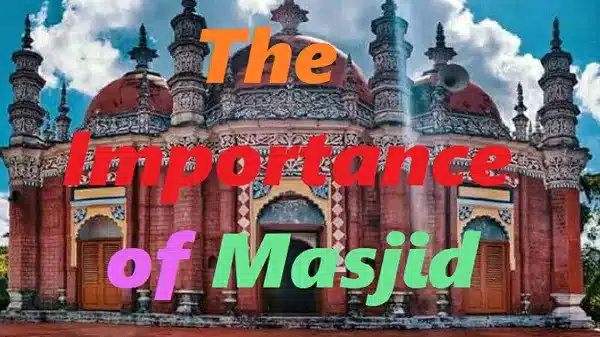Masjid: A Place of Worship and Community
The masjid, or mosque, holds a special place in the hearts of Muslims around the world. It is not just a place of prayer but also a center for community engagement, education, and social services. In this article, we will explore the rich history, significance, architectural features, and various roles of a masjid in the community.
1. Introduction
The mosque or masjid is a fundamental institution in Islam, serving as a center of worship, education, and community life for Muslims worldwide. This article will explore
2. History of Masjid
The history of masjids dates back to the time of Prophet Muhammad (peace be upon him) in the 7th century. The first masjid, Masjid al-Quba, was built in Medina, Saudi Arabia, under the direct guidance of the Prophet. Since then, masjids have been established in every corner of the world, reflecting the global presence of Islam.
3. Significance of Masjid
Masjids hold immense significance in the lives of Muslims. They are not just places of worship but also serve as educational institutions, community centers, and hubs for various social activities. Mas provide spiritual nourishment, guidance, and a sense of belonging to the Muslim community.
4. Architectural Features of Masjid
Mas exhibit diverse architectural styles influenced by the regions where they are built. They often feature a dome and minaret, symbolizing the grandeur of Islamic architecture.
The prayer hall, or musallah, is the central area where Muslims gather for congregational prayers. Intricate calligraphy, geometric patterns, and beautiful artwork adorn the walls, showcasing the aesthetic beauty of masjids.
আরো পড়ুন……
দাড়ি রাখা কি পুরুষদের স্বাস্থ্যের জন্য ভালো?
নামাজের দোয়া ও সূরা (বাংলা অনুবাদ,অর্থসহ আরবি)
তাহাজ্জুদ নামাজ কিভাবে আদায় করবেন
5. Role of Masjid in the Community
Mas play a vital role in the community, extending their services beyond prayers. They organize religious classes, lectures, and seminars to educate people about Islam. They also offer counseling services, helping individuals navigate through life’s challenges. Mas serve as a platform for social interactions, fostering unity, and strengthening the bonds of brotherhood and sisterhood.
6. Masjid Etiquette
Respecting the sanctity of the masjid is essential for every visitor. Observing proper etiquette includes performing ablution (wudu) before entering the prayer area, maintaining a peaceful atmosphere, and avoiding distractions. Additionally, dressing modestly and removing shoes before entering the prayer hall are common practices.
7. The Importance of Friday Prayer
Friday prayer, also known as Jummah, holds special significance in Islam. Muslims gather in the masjid to listen to the sermon (khutbah) delivered by the imam. It is an opportunity for spiritual rejuvenation, community bonding, and gaining knowledge. Friday prayer strengthens the unity
The History of the Masjid
The first mosque was established in Medina, Saudi Arabia, by the Prophet Muhammad, who constructed the structure to serve as a place of prayer and gathering for the early Muslim community. The design of the mosque was simple, consisting of a rectangular courtyard enclosed by a roofed prayer hall, with the qibla or direction of prayer facing towards the Kaaba in Mecca.
Over time, the masjid evolved to include a range of functions, from serving as a center of learning, to providing social welfare services, and acting as a platform for political activism. Today, there are millions of mosques worldwide, each reflecting the cultural, historical, and architectural traditions of their respective regions.
The Architecture of the Masjid
The design of the mosque reflects the Islamic concept of tawhid or the oneness of God, with the central focus being the mihrab or niche that indicates the direction of prayer. The prayer hall is usually rectangular in shape and may include additional features such as a minbar or pulpit from which the Friday sermon is delivered, and a dome or minaret.
The mas’s architecture varies widely depending on the region and the period in which it was constructed, with notable examples including the Great Mosque of Cordoba in Spain, the Blue Mosque in Istanbul, and the Sheikh Zayed Grand Mosque in Abu Dhabi.
The Role of the Masjid in Contemporary Society
In addition to serving as a place of worship, the mosque plays a vital role in contemporary society as a center for education, social services, and community engagement. Many mosques offer classes in Islamic studies, language, and the sciences, while others provide support to refugees, the homeless, and other vulnerable populations.
The masjid also serves as a hub for social and cultural events, such as weddings, funerals, and festivals, and may act as a platform for interfaith dialogue and collaboration.
Conclusion
The mas is a vital institution in the Muslim world, serving as a center of worship, education, and community engagement. Its history, architecture, and contemporary role reflect the diverse and dynamic nature of Islamic civilization and its enduring legacy. By understanding the significance of the mas, we can gain a deeper appreciation for the rich cultural heritage and religious traditions of the Muslim world.
FAQs
Q: What is the difference between a mas and a mosque? A: There is no difference between the terms “mas” and “mosque” – both refer to the same thing, a place of worship for Muslims.
Q: Can non-Muslims visit a mas? A: Yes, many mas welcome visitors of all faiths and backgrounds and may offer guided tours or other educational programs.
Q: Do all mas have the same design? A: No, the design of the mas varies widely depending on the region and the period in which it was constructed.
Q: Can women pray in a mas? A: Yes, women are allowed to pray in a mas, although the arrangements for women’s prayer may vary depending on the specific mas.
Q: Are mas only found in Muslim countries? A: No, there are mas located all around the world, including in non-Muslim majority countries.

Leave a Reply